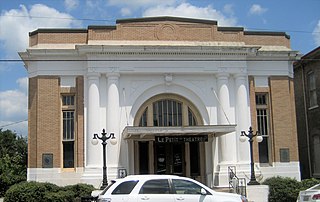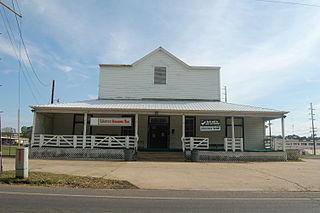
Terrebonne Parish is a parish located in the southern part of the U.S. state of Louisiana. At the 2020 census, the population was 109,580. The parish seat is Houma. The parish was founded in 1822. Terrebonne Parish is part of the Houma-Thibodaux metropolitan statistical area.

Thibodaux is a city in, and the parish seat of, Lafourche Parish, Louisiana, United States, along the banks of Bayou Lafourche in the northwestern part of the parish. The population was 15,948 at the 2020 census. Thibodaux is a principal city of the Houma–Bayou Cane–Thibodaux metropolitan statistical area.

Houma is the largest city in and the parish seat of Terrebonne Parish in the U.S. state of Louisiana. It is also the largest principal city of the Houma–Bayou Cane–Thibodaux metropolitan statistical area. The city's government was absorbed by the parish in 1984, which currently operates as the Terrebonne Parish Consolidated Government.

Oak Alley Plantation is a historic plantation located on the west bank of the Mississippi River, in the community of Vacherie, St. James Parish, Louisiana, U.S. Oak Alley is named for its distinguishing visual feature, an alley or canopied path, created by a double row of southern live oak trees about 800 feet long, planted in the early 18th century — long before the present house was built. The allée or tree avenue runs between the home and the River. The property was designated a National Historic Landmark for its architecture and landscaping, and for the agricultural innovation of grafting pecan trees, performed there in 1846–47 by a gardener. It was first known as Bon Séjour.

The New Smyrna Sugar Mill Ruins is a historic site in New Smyrna Beach, Florida, at 600 Old Mission Road, one mile west of the Intracoastal Waterway. On August 12, 1970, it was added to the U.S. National Register of Historic Places.

The Jarrell Plantation State Historic Site is a former cotton plantation and state historic site in Juliette, Georgia, United States. Founded as a forced-labor farm worked by John Jarrell and the African American people he enslaved, the site stands today as one of the best-preserved examples of a "middle class" Southern plantation. The Jarrell Plantation's buildings and artifacts all came from the Jarrell family, who farmed the land for over 140 years. Located in the red clay hills of the Georgia piedmont, It was added to the National Register of Historic Places in 1973. It is a Georgia state park in Jones County.

Melrose Plantation, also known as Yucca Plantation, is a National Historic Landmark located in the unincorporated community of Melrose in Natchitoches Parish in north central Louisiana. This is one of the largest plantations in the United States built by and for free blacks. The land was granted to Louis Metoyer, who had the "Big House" built beginning about 1832. He was a son of Marie Thérèse Coincoin, a former slave who became a wealthy businesswoman in the area, and Claude Thomas Pierre Métoyer. The house was completed in 1833 after Louis' death by his son Jean Baptiste Louis Metoyer. The Metoyers were free people of color for four generations before the American Civil War.

The Varner–Hogg Plantation State Historic Site is a historical site operated by the Texas Historical Commission. The site was the home of former Governor of Texas James S. Hogg and his family. The site is located outside West Columbia, in Brazoria County.

Kent Plantation House is the oldest standing structure in Central Louisiana. Listed since 1971 in the National Register of Historic Places, Kent House is located in Alexandria in Rapides Parish. The plantation house is a representation of southern plantation life between 1795 and 1855. The main structure was erected in 1800 with the labor of people enslaved by Pierre Baillio. The bousillage Creole house and restored period outbuildings are now a showcase for tourists.

Ardoyne Plantation House is located on Highway 311 in Schriever, Louisiana, just northwest of Houma, Louisiana. It was built 1894 and added to the National Register of Historic Places on November 1, 1982.

There are two heritage railways in Kauai, the birthplace of Hawaiian railroading. It was added to the National Register of Historic Places on January 19, 1979.

Julia Stockton Dinsmore was an American poet best remembered for her association with the Dinsmore Homestead in Kentucky, now on the National Register of Historic Places and a museum open to the public. She raised sheep and grew grapes on the homestead farm. A collection of her poems, Verses and Sonnets, was published in 1910.

The Ormond Plantation House is a French Colonial-style, Creole plantation house located in Destrehan, St. Charles Parish, Louisiana, United States.

Bocage Plantation is a historic plantation in Darrow, Ascension Parish, Louisiana, about 25 miles (40 km) southeast of Baton Rouge. The plantation house was constructed in 1837 in Greek Revival style with Creole influences, especially in the floorplan. Established in 1801, the plantation was added to the National Register of Historic Places on June 20, 1991.
Stephen Minor (1760–1815) was an American plantation owner and banker in the antebellum South.

Captain William J. Minor was an American planter, slave owner, and banker in the antebellum South. Educated in Philadelphia, he lived at the Concord plantation in Natchez, Mississippi, and served as the second President of the Agricultural Bank. He was the owner of three large sugar plantations in Louisiana and supported the Union during the Civil War for the stability of the sugar trade.

Fairymead House is a heritage-listed homestead at Thornhill Street, Bundaberg North, Bundaberg Region, Queensland, Australia. It was designed by John Shedden Adam and built in 1890. It was added to the Queensland Heritage Register on 22 February 2002.
The Acadia Plantation was a historic plantation house in Thibodaux, Louisiana, U.S.. It was the plantation of James Bowie, Rezin P. Bowie, and Stephen Bowie. James "Jim" Bowie, served in the Battle of the Alamo. It was listed on the National Register of Historic Places on May 29, 1987. It was demolished in 2010.
The Asphodel Plantation is a historic building and former plantation, completed in c.1830 and located about 3.5 miles (5.6 km) south of Jackson, Louisiana, United States. It was built by Benjamin Kendrick, a cotton planter and slave owner.

Caspiana Plantation Store is an American historic building and a former plantation store built in 1906, located at 1300 Texas Street in Natchitoches, Louisiana. The store served as part of the crop-lien system, during the time of sharecropping which impacted the lives of many African American workers.



















